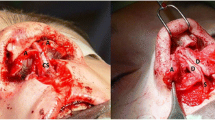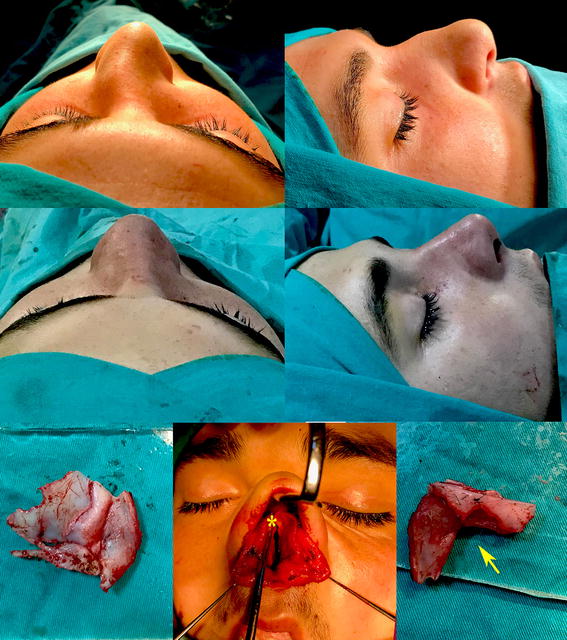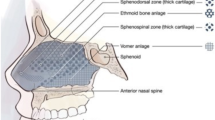Abstract
Septorhinoplasty is particularly challenging among revision surgeries for cleft sequelae. The challenge of cleft septorhinoplasty is mainly due to the complex anatomy of nose, deformity of each of its components and the difficulty and lack of clarity in surgical management. From 2014 to 2017, 26 patients with cleft lip nose deformity were operated by the same cleft team. The study was conducted to assess the improvement in nasal airway and appearance following secondary rhinoplasty with extracorporeal septoplasty. Post operatively each patient was evaluated using the standard modified rhinoplasty outcome evaluation questionnaire, a validated instrument that aids in stratifying patients according to their subjective response. All patients reported great relief of nasal obstruction and improved breathing. More than 80% of our patients were satisfied with improved aesthetics and reported better self-confidence. Secondary cleft rhinoplasty with extracorporeal septoplasty surgery significantly improves the cosmesis and nasal airway opening, subsequently giving them improved self-confidence.



Similar content being viewed by others
References
Gubisch W (2006) Twenty-five years’ experience with extracorporeal septoplasty. Fac Plast Surg 22(4):230–239
Wang Z, Wang P, Zhang Y, Shen G (2017) Nasal airway evaluation after Le Fort I osteotomy combined with septoplasty in patients with cleft lip and palate. J Craniofac Surg 28(1):207–211
Parrilla C, Artuso A, Gallus R, Galli J, Paludetti G (2013) The role of septal surgery in cosmetic rhinoplasty. Acta Otorhinolaryngol Ital 33(3):146–153
Alsarraf R, Larrabee WF Jr, Anderson S, Murakami CS, Johnson CM Jr (2001) Measuring cosmetic facial plastic surgery outcomes: a pilot study. Arch Fac Plast Surg 3(3):198–201
Sawyer AR, Robinson S, Cadier M (2017) Prospective patient—related outcome evaluation of secondary cleft rhinoplasty using a validated questionnaire. Cleft Palate Craniofac J 54(4):436–441
Pawar S, Wang TD (2014) Secondary cleft rhinoplasty. JAMA Fac Plast Surg 16(1):58–63
Posnick JC, Tompson B (1993) Modification of the maxillary Le Fort I osteotomy in cleft-orthognathic surgery: the bilateral cleft lip and palate deformity. J Oral Maxillofac Surg 51(1):2–11
Allori AC, Mulliken JB (2017) Evidence-based medicine: secondary correction of cleft lip nasal deformity. Plast Reconstr Surg 140(1):166e–176e
Hsieh T, Dedhia R, Del Toro D, Tollefson T (2017) Cleft septorhinoplasty: form and function. Fac Plast Surg Clin N Am 25(2):223–238
Shih CW, Sykes JM (2002) Correction of the cleft-lip nasal deformity. Fac Plast Surg 18(4):253–262
Vass G, Mohos G, Bere Z, Ivan L, Varga J, Piffko J et al (2016) Secondary correction of nasal deformities in cleft lip and palate patients: surgical technique and outcome evaluation. Head Face Med 12(1):34
Most SP (2006) Anterior septal reconstruction: outcomes after a modified extracorporeal septoplasty technique. Arch Fac Plast Surg 8(3):202–207
Haack J, Papel ID (2009) Caudal septal deviation. Otolaryngol Clin N Am 42(3):427–436
Fisher DM, Mann RJ (1998) A model for the cleft lip nasal deformity. Plast Reconstr Surg 101(6):1448–1456
Acknowledgements
Authors would like to thank Dr. Aarathi Krishnan for statistical guidance.
Author information
Authors and Affiliations
Corresponding author
Ethics declarations
Conflict of interest
The authors declare that they have no conflict of interest and there was no funding or grants involved.
Informed Consent
Informed consent was obtained from all individual participants included in the study. Additional informed consent was obtained from all individual participants for whom identifying information is included in this article.
Additional information
Publisher's Note
Springer Nature remains neutral with regard to jurisdictional claims in published maps and institutional affiliations.
Rights and permissions
About this article
Cite this article
Oommen, J., Koyappathody, H.M., Kalathingal, K. et al. Three Dimensional Rhinoplasty and Nasal Airway Improvement in Cleft-Nose Deformity. Indian J Otolaryngol Head Neck Surg 71, 512–516 (2019). https://doi.org/10.1007/s12070-019-01690-2
Received:
Accepted:
Published:
Issue Date:
DOI: https://doi.org/10.1007/s12070-019-01690-2




